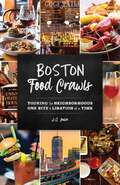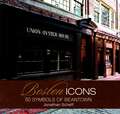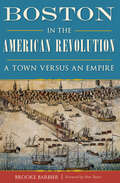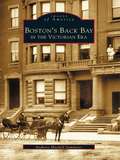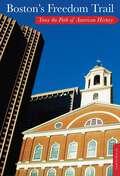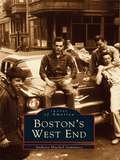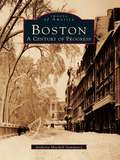- Table View
- List View
Boston Curiosities: Quirky Characters, Roadside Oddities, And Other Offbeat Stuff (Curiosities Series)
by Erik Sherman Bruce GellermanYour round-trip ticket to the wildest, wackiest, most outrageous people, places, and things Beantown has to offer!
Boston Food Crawls: Touring the Neighborhoods One Bite & Libation at a Time (Food Crawls)
by J.Q. LouiseSip and taste your way through Boston. Boston Food Crawls is an exciting culinary tour through this historic yet modern city. Tap into the unique vibes and flavors of neighborhood restaurants and bars. Hit the Theater District for dinner and a show. Just in town for the weekend? Take the classy but sassy crawl through the Back Bay. Lifelong Bostonians will love the Classic Chowder Crawl (did your favorite make the list?), and everyone will find something new on the bonus rooftop crawl. Put on your walking shoes and your stretchy pants, and dig into the Hub one dish at a time.
Boston Icons: 50 Symbols of Beantown (Icons)
by Jonathan ScheffProfiled here are fifty classic symbols of this extraordinary city, revealing little-known facts, longtime secrets, and historical legends.
Boston Light (Images of America)
by Sally R. Snowman James G. ThomsonOn September 14, 1716, Boston Light became the first lighthouse established in Colonial America. With many ships floundering in the treacherous waters of the Massachusetts harbor, there was a great need for navigational aid. At night and during storms, it was difficult to discern the entrance to the main shipping channel of Nantasket Roads, situated between the Brewster islands and the town of Hull. The ledges had become a graveyard for ships, resulting in great loss to human life and cargo--a deterrent to European colonization efforts. Ship captains and merchants petitioned the colonial government for a lighthouse to be erected on Little Brewster Island as a way of safe passage to the inner harbor. Three hundred years later, Boston Light continues to serve its purpose. Today, the lighthouse is protected by an ever-present Coast Guard civilian keeper and a cadre of specially trained Coast Guard Auxiliary volunteer assistant keepers.
Boston Like a Local: By the People Who Call It Home (Local Travel Guide)
by DK Eyewitness Cathryn Haight Meaghan Agnew Jared Emory RanahanKeen to explore a different side of Boston? Like a Local is the book for you.This isn&’t your ordinary travel guide. Beyond Boston&’s rich history and world-famous universities are experimental breweries, super-cool jazz clubs and design-led jewellery stores that locals love – and that&’s where this book takes you.Turn the pages to discover:- The small businesses and community strongholds that add character to this vibrant city, recommended by true locals.- 6 themed walking tours dedicated to specific experiences such as flea markets and movie theatres.- A beautiful gift book for anyone seeking to explore Boston.- Helpful &‘what3word&’ addresses, so you can pinpoint all the listed sights.Compiled by three proud Bostonians, this stylish travel guide is packed with Boston&’s best experiences and hidden spots, handily categorised to suit your mood and needs.Whether you&’re a restless Bostonian on the hunt for a new hangout, or a visitor keen to discover a side you won&’t find in traditional guidebooks, Boston Like A Local will give you all the inspiration you need.About Like A Local:These giftable and collectable guides from DK Eyewitness are compiled exclusively by locals. Whether they&’re born-and-bred or moved to study and never looked back, our experts shine a light on what it means to be a local: pride for their city, community spirit and local expertise. Like a Local will inspire readers to celebrate the secret as well as the iconic – just like the locals who call the city home.Looking for another guide to Boston? Explore further with DK Eyewitness or Top 10 Guides to Boston.
Boston Marathon: History by the Mile (Sports Ser.)
by Paul C. Clerici&“Clerici brings the race to life through . . . stories about every statue, landmark and portion of the course from its start in 1897 to its current incarnation&” (MetroWest Daily News). From Hopkinton to Boylston Street, the beloved 26.2 miles of the Boston Marathon mark historic moments and memories dating back to 1897. Town by town and step by step, follow author, journalist, and runner Paul C. Clerici as he goes deeper into each town and city along the route with firsthand descriptions of the course from the uphill climbs to the spirited sprints. Insightful anecdotes, from the naming of Heartbreak Hill to the incorporation of women runners, reveal meaningful racing heritage along the route. This comprehensive and unique journey also explores the stories behind notable landmarks, statues, and mile markers throughout the course. Woven into the course history is expert advice on how to run each leg of the race from renowned running coach Bill Squires. Whether you&’re a runner, spectator, or fan, Boston Marathon: History by the Mile has it all. Includes photos!
Boston Noir 2: The Classics (Akashic Noir #0)
by Dennis Lehane, Mary Cotton, Jaime ClarkeDennis Lehane returns to coedit, with Cotton & Clarke, the sequel to the best-selling evergreen anthology Boston Noir, culling classic stories from the city’s dark literary legacy.“The contributor list is delightfully quirky . . . The collection’s unifying element is a deep understanding of Boston’s Byzantine worlds of race and class—as seen terrifyingly in Andre Dubus’s tale of mill town resentment and pampered preppies.” —Boston GlobeFeaturing stories by: Linda Barnes, Jason Brown, Andre Dubus, Chuck Hogan, George Harrar, George V. Higgins, Dennis Lehane, Joyce Carol Oates, Robert B. Parker, David Ryan, Kenneth Abel, Barbara Neely, Hannah Tinti, and David Foster Wallace.From the introduction by Jaime Clarke, Mary Cotton, & Dennis Lehane:“What is noir and what is not inhabits a gray area. Its definition is continually expanding from the previous generation’s agreed-upon notion that noir involves men in fedoras smoking cigarettes on street corners. Noir alludes to crime, sure, but it also evokes bleak elements, danger, tragedy, sleaze, all of which is best represented by its root French definition: black. We used this idea as our guide for this sequel to the best-selling Boston Noir anthology . . ."The commonwealth is an endless source of fascinating landscapes: the autumnal light spreading across the Charles River; the ice floes in the wintry Boston Harbor; a spring air tantalizing leaves in Harvard Yard; the salty taste of summer as sunbathers peer into the horizon, shielding their eyes from the glare, squinting into the middle distance. Beyond the postcard fabric, though, lies a community populated by broken families, criminal minds, voyeurs, and outsiders. They look like you and me. These are their stories.”
Boston Youth Symphony Orchestras (Images of America)
by Krysten A. KechesIn 1958, under the direction of Prof. Marvin Rabin, the Boston University College of Fine Arts established a youth orchestra for junior and senior high school students from the Greater Boston area. The Boston Youth Symphony Orchestras (BYSO), formerly known as the Greater Boston Youth Symphony Orchestras, has flourished over the past 50 years, expanding beyond the original single orchestra and launching many new artistic initiatives. BYSO members have experienced countless unforgettable moments, including performances at the White House, Carnegie Hall, and renowned concert venues across the world. Today, under the musical leadership of Federico Cortese, the BYSO serves over 400 young musicians from 126 communities throughout New England. The BYSO is one of Boston's most prestigious arts organizations, with a programmatic scope that includes three full symphonic orchestras, a string orchestra, a preparatory wind ensemble, four chamber orchestras, 50 chamber music ensembles, and a nationally recognized string training program for underrepresented youth from inner-city communities. The BYSO has selected images from its extensive archives to exhibit the rich history of this organization.
Boston and Beyond: Discovering Cities, Harbors, and Country Charms
by Sheila MoeschenThe Boston region is overrun with classic beauty—cityscapes, snow-capped mountains, tranquil harbors, and sleepy historic hamlets. Show-stopping, scene-stealing, I-pulled-over-for-this charm exists in every season all over the Boston region. All you have to do is open your eyes and see it. Boston and Beyond takes readers on nearly 30 tours—in Boston or an hour or two from the city—through one of the most idyllic parts of America in a wholly unique way.Accompanied by sumptuous photography, Boston and Beyond is a visual love song honoring the essence of what makes the region singular and guides readers to dozens of places that offer hidden charms, fun, novel discoveries, and original experiences. The locations featured in this book are within striking distance of Boston, allowing for convenient day trips and enjoyable excursions to charming locales.
Boston in Motion (Images of America)
by Anthony M. Sammarco Frank CheneyBoston in Motion, the sequel to Trolleys under the Hub, is an intriguing collection of photographs that captures the history of transportation in and around Boston. Authors Frank Cheney and Anthony M. Sammarco trace the stories from the earliest days of public transport with the Winnissimmet Ferry to the MBTA of today. A city known for its comprehensive public transportation, Boston has hosted every type of transit known to urban America. From the ferry, the horse railway, and the omnibus to the steam railroad and, eventually, the subway and bus systems, Boston has always been at the forefront of transportation advancements. The former "El" (the Boston Elevated Railway), the Old Colony Railroad, the Red Line, and the East Boston Line dramatically changed the face of Boston in the late nineteenth and early twentieth centuries. In Boston in Motion, these advancements are presented and explored in a riveting collection of original photographs.
Boston in the American Revolution: A Town Versus an Empire (Military Ser.)
by Brooke BarbierDiscover the people and places of colonial Boston during the tumultuous years of rebellion—illustrations included. In 1764, a small town in the British colony of Massachusetts ignited a bold rebellion. When Great Britain levied the Sugar Act on its American colonies, Parliament was not prepared for Boston&’s backlash. For the next decade, Loyalists and rebels harried one another as both sides revolted and betrayed, punished and murdered. But the rebel leaders were not always the heroes we consider them today. Samuel Adams and John Hancock were reluctant allies. Paul Revere couldn&’t recognize a traitor in his own inner circle. And George Washington dismissed the efforts of the Massachusetts rebels as unimportant. With a helpful guide to the very sites where the events unfolded, historian Brooke Barbier seeks the truth and human stories behind the myths. Barbier tells the story of how a city radicalized itself against the world&’s most powerful empire and helped found the United States of America.
Boston's Back Bay in the Victorian Era
by Anthony Mitchell SammarcoThe Back Bay was one of Boston's premier residential neighborhoods between 1837 and 1901. From its quagmire beginnings and with the creation of the Boston Public Garden in the 1830s, the Back Bay was envisioned as an urbane and sophisticated streetscape of stone and brick row houses. The major center of the neighborhood became Art Square, now known as Copley Square, which was surrounded by Trinity Church, New Old South Church, Second Church of Boston, the Boston Public Library, and S.S. Pierce and Company. With images of swan boats and architectural delights, Boston's Back Bay in the Victorian Era illuminates a particularly vibrant period in this intriguing and relatively new neighborhood's past.
Boston's Best Dive Bars
by Luke O'NeilBoston's Best Dive Bars features opinionated reviews of 100 of the grungiest and grittiest drinking establishments in Beantown. If you want to avoid the tourist traps listed in those "other" bar guides and find out where real Bostonians do their drinking, then this is the book for you.Luke O'Neil has been covering arts and nightlife in Boston for ten years. For years he wrote a popular column called Barcode in The Boston Globe, where he still writes about cocktails and the restaurant and bar scene. He also pens a bar column called Thursty in the Boston Metro, the Liquid column in Stuff Magazine, and has written about bars for Boston Magazine and Black Book.
Boston's Financial District
by Anthony Mitchell SammarcoBoston's financial district is considered the heart of New England's banking and finance. It is a veritable overlay of sleek modern office buildings and elegant high-rise structures of the early twentieth century. In the center of this contemporary skyline is evidence of the financial district's long history. Boston's first skyscraper, the Boston Custom House tower, stands high from where it was built in 1915 on top of the original 1849 custom house building.Boston's Financial District chronicles the steady change from a romantic neighborhood to numerous banking and business houses. It was originally known as Old South End and was a residential site of elegant mansions designed by Charles Bulfinch and located on tree-lined squares and streets that emulated the aristocratic boroughs of London. The photographs in Boston's Financial District show evidence of the destruction wreaked by the Great Boston Fire of 1872 and the rebuilding of Boston's center of commerce. With its well-known banks and businesses, the financial district has witnessed some of the most monumental and influential historical changes in the city of Boston.
Boston's Freedom Trail: Trace the Path of American History
by Cindi D. PietrzykA thorough yet concise walking guide to one of America&’s most important historic destinationsRelive the birth of America along Boston&’s historic two-and-a-half-mile Freedom Trail with this guide to twenty-six legendary landmarks—including the site of the Boston Massacre and the Bunker Hill Monument. This new edition is fully updated to include the most current information on the sites, including admission fees, hours of operation, and more. It also features a fresh cover treatment and a new, travel-friendly trim size. Put on your walking shoes and visit:- Faneuil Hall, where the citizens of Boston voted their &“opposition to Tyrants and their Minions&”- Paul Revere&’s house, the only seventeenth-century wooden dwelling still standing in any major American city- The Old South Meeting House, where Sam Adams&’s December 16, 1773 oration led to the Boston Tea Party- The Old State House, the site of Boston&’s first public reading of the Declaration of Independence
Boston's Historic Hub: A Tour of the Metro Region's Top National Landmarks
by David Lyon Patricia HarrisWhat do the oldest black church in the country, an Arts-and-Crafts-style artists' studio building, a concrete football stadium, and an acoustically perfect performance space have in common? They are all National Historic Landmarks located in Boston. In fact, the city boasts more National Historic Landmarks per square mile than any other major city in the country. Given Boston's long history and record of accomplishments, it's really not surprising that 57 properties—from the nation's oldest subway tunnel to a floating lighthouse—have received this designation. Add in the adjoining cities of Cambridge and Brookline and the number swells. Historic Boston includes the most rewarding and easily visited landmarks. That's a lot of history in 103 square miles. The Secretary of the Interior designates the status of National Historic Landmark to places considered &“exceptional because of their abilities to illustrate U.S. heritage.&” More simply put, they are the places that resonate broadly with us, that we cherish, and want to pass on to future generations. The list is surprisingly diverse. In metro Boston, it includes an historic church with a stunning collection of Tiffany windows, a Transcendentalist community, a Grand Banks schooner, and the home and studio of landscape architect Frederick Law Olmsted.
Boston's North End
by Anthony Mitchell SammarcoThe streets of Boston's North End, some laid out in the seventeenth century, exude a rich history that has included every generation of immigrants to Boston since 1630. An active port, the neighborhood of the North End also included churches of every denomination, historic homes, and early commercial concerns. Immigrants from Russia, Ireland, Germany, Italy, and most other European countries settled in the North End and contributed to itsdevelopment over the years. Today, most visitors to Boston tour the North End and see the Paul Revere House and the famous Old North Church. On the weekends, shoppers visit the bustling Haymarket and attend feasts and festivals amidst the appetizing ambiance of restaurant row. This thriving, lively area of town is an alluring meeting place forresidents and tourists alike.
Boston's North End
by Anthony Mitchell Sammarco Charlie RosenbergSince Boston's settlement in 1630, the North End has developed from a neighborhood of residences and artisan shops. Known for the nationally important Paul Revere House, which is the oldest standing building in Boston, and the Old North Church, the North End is a destination for tourists.
Boston's South End
by Anthony Mitchell SammarcoOriginally a narrow, barren strip of land known as the Neck, Boston's South End grew from a lonely sentry post and execution grounds to what is today the largest Victorian neighborhood in the United States. With the filling of the South Cove in the 1830s, the area became one of the greatest planned residential districts of its time, a heritage preserved in unique architectural features such as red brick swell bay facades, elaborate balusters, and fanciful porches.
Boston's West End
by Anthony Mitchell SammarcoWithin these pages, author Anthony Mitchell Sammarcobrings to life the history of Boston's West End--thearea of the city bound by the Charles River and Storrow Drive as well as North Station, City Hall Plaza, and Myrtle Street. Once a thriving, energetic, and diverse neighborhood, the West End was slated for complete removal following World War II. In over 200 marvelous photographs, this collection recaptures fond memories for former residents and shows newcomers the history of the West End. Now the site of luxury, high-rise apartment buildings, condominiums, and stores, Boston's West End was once the site of many Bulfinch-designed townhouses owned by prominent families. In later years, the neighborhood was home to a diverse ethnic and religious community of families who arrived in Boston from all parts of the world. Today,three decades after the West End was virtually leveled, it is still fondly remembered by many who once called it home.
Boston, Cape COD & The Islands
by Marie Morris Laura ReckfordLarge numbers of Americans supplement their visits to Boston with easily-accomplished excursions to Cape Cod, Martha's Vineyard and Nantucket. Or else they plan vacations to these awesomely-popular islands whose gateway is Boston. We're proud to group all four destinations into one easily-read, light-to-carry guidebook.
Boston, New York (Images of America)
by Sherrie L. PlutaIn 1803, when Charles Johnson and his brother Oliver left their family in Cayuga County to move west to the Boston Valley, they brought their pioneer spirit and strength with them to an untouched wilderness. The valley was a serene meadow, and the hills surrounding it were perfect for farming and raising cattle and sheep. As others came with their families, the wilderness became tame, and the town grew as the community built harness shops, cheese factories, sawmills, and schools. In the years that followed, the town experienced both tragic and joyous events. From John Love's murder in 1824, through a typhoid epidemic in 1840, the birth of a world-famous opera singer in 1868, the construction in 1903 of the Buffalo and Susquehanna Railroad through town, the genesis of the Boston Telephone Company in 1904, the emergence of the town's many churches, and the building of three fire companies, Boston shaped itself into the town it is today.
Boston: A Century of Progress
by Anthony Mitchell SammarcoOn March 4, 1822, the townsfolk of Boston voted to incorporate their town as the City of Boston. A great change had just taken place, but even greater changes were to come during the ensuing century, as Boston's population grew from 50,000 to 750,000 by 1922 and as it developed from a colonial town into the "Hub of the Universe." Boston: A Century of Progress brings to life one hundred amazing years, from 1822 to 1922. More than two hundred fascinating images are combined with compelling text to take us on a mesmerizing journey back into our past and bring us face to face with the people, places, and events which shaped Boston's destiny. Through these images we explore neighborhoods ranging from the North End to Downtown, Beacon Hill, Back Bay, and Fenway. We see landmarks and buildings both familiar and long-gone - schools, churches, mansions, stores, tenements, and parks. We meet not only the movers and shakers but also the ordinary people who lived, worked, and played in Victorian Boston, including the vast numbers of immigrants (by 1850, half of all Bostonians were foreign-born).
Boston: A Historic Walking Tour
by Anthony Mitchell SammarcoOliver Wendell Holmes coined the Massachusetts State House as the "Hub of the Universe." In Boston: A Historic Walking Tour, readers are guided on a series of downtown walking tours that radiate out from this Boston landmark. Featuring different excursions that explore Boston's prominent neighborhoods and districts, visitors and natives alike will see how this city has become one of the country's oldest cultural destinations. Boston's growth and development in the 19th and 20th centuries has contributed to it becoming the unofficial "Capital of New England"; its economic and cultural impact on the entire New England region is far reaching. Although Boston is known for its notoriously crooked streets and narrow alleys, it is a mecca for walkers looking to take in historic sites and surround themselves with history. Walk along Tremont, Washington, Beacon, and Summer Streets to explore downtown Boston. Saunter down Beacon Street on Beacon Hill and Boylston Street in the Back Bay to take in the city's most beloved sites.
Boswell's Enlightenment
by Robert ZaretskyThroughout his life James Boswell struggled to fashion a clear account of himself, but try as he might he could not reconcile the truths of his era with those of his religious upbringing. Few periods better crystallize this turmoil than 1763-1765, the years of his Grand Tour and the focus of Robert Zaretsky's thrilling intellectual adventure.

